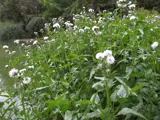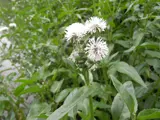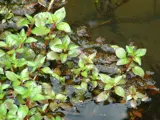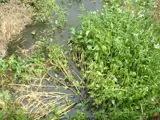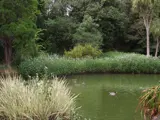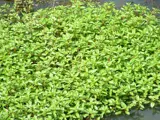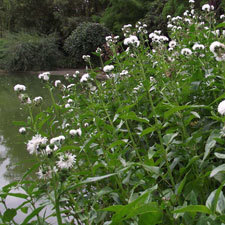 Senegal tea
Senegal tea
Common name: Senegal tea; Temple plant; Costata,
Botanical name: Gymnocoronis spilanthoides
Management programme: Eradication
Senegal Tea is native to South America. It was introduced to New Zealand through the ornamental aquatic trade and sold as costata. It was recorded as naturalised in New Zealand by 1991.
Why is it a pest?
- Matures and grows quickly, forming dense mats and scrambling over other species.
- Produces few seeds, but they are long-lived and well dispersed.
- Tolerates warm to hot temperatures, most soils and water nutrient levels.
Where is it found?
- Wetlands and swamps, rivers and streams, and wet ground, especially in the North Island.
- Seed, stem and root fragments can move downstream with water flow, and new areas are infested by seed and fragments moved by diggers and on boats and fishing equipment, and by the dumping of aquarium contents and ponds. Seeds and fragments can also be spread in soil movement and on the hooves of livestock.
- There are currently five active sites in the Bay of Plenty.
What does it look like?
- Perennial aquatic herb (<1m tall) with finely fibrous roots
- Hollow, inflated, floating stems (1-1.5m long and 5-10mm diameter)
- Clover-like fragrant flowerheads (November to May) with many thin white 'petals' (florets), followed by yellow-brown seeds (5mm diameter).
- Dormant over winter and dies back but resprouts in spring.
What are the rules?
Eradication
Eradication pests are present in the region but are limited in their size or extent of infestation. The eradication of these organisms is a feasible and cost-effective solution. The Bay of Plenty Regional Council is responsible for their control or eradication from the region. Action may be required from landowners or occupiers to support a control operation.
How do you get rid of it?
Council will maintain control and management of Senegal tea. It is a very high risk plant and requires intensive monitoring and control.
N.B: Stems and roots and seeds can re-infest bare sites, so follow-up three monthly until this weed is eliminated. Don't graze the area, as stock will disperse fragments.
Images

